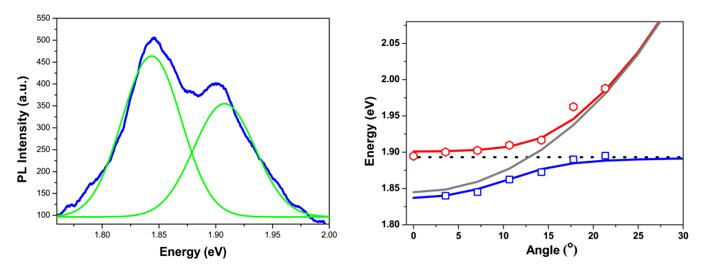
Vacuum Rabi splitting is a fundamental quantum phenomenon, and the implementation of solid-state single-oscillator vacuum Rabi splitting will lead to true strong coupling. A cavity can control the spontaneous emission of an emitter and the cavity quantum electrodynamics regime. Additionally, bound states can exist above the continuum threshold. These special states are called bound states in the continuum (BICs) and appear as a resonance that does not decay. Recently, photonic BICs in low-refractive-index materials on high-refractive-index substrates have been demonstrated theoretically and experimentally.
In a recent study, Prof. XU Xingsheng from the Institute of Semiconductors of the Chinese Academy of Sciences reported for the first time the strong coupling and Rabi splitting between a single colloidal quantum dot (CQD) and a Fabry-Perot (F-P) cavity with dielectric low-refractive-index/high-refractive-index material based on photoluminescence (PL) spectra at room temperature.
By combining CQDs and a low-refractive-index/high-refractive-index hybrid dielectric material, the researchers investigated the PL spectral image from CQDs. They observed PL spectra with two-peak structure, anticrossing between the CQD exciton and cavity-mode dispersion relations, and obtained Rabi splitting energy of 76 meV and 42 meV for high-concentration CQDs and single CQDs, respectively.
They characterized the second-order correlation function of emission from low-concentration CQDs using a Hanbury-Brown and Twiss setup and a time-correlated single-ph oton counting system, demonstrated that the CQDs used are single quantum dots, and the corresponding PL is single photon emission.
oton counting system, demonstrated that the CQDs used are single quantum dots, and the corresponding PL is single photon emission.
Before this study, strong coupling between a single emitter and a dielectric cavity at room temperature based on PL spectra has not been reported. Because PL is incoherent light, splitting of the PL spectrum into two peaks can only occur in the strong coupling process, and thus, researchers recognized this phenomenon as a decisive sign of Rabi splitting.
According to experimental verification and theoretical analysis,the researchers proved that the Rabi splitting based on the PL spectra is due to the strong coupling between the CQD exciton and the F-P BICs formed in the hybrid structure of the low-refractive-index/high-refractive-index material.
This study has found the first evidence of strong coupling between a single photon and a BIC in a dielectric membrane based on PL spectra at room temperature, which will provide an important platform for quantum integrated circuits and quantum information sciences.
"This low-refractive-index/high-refractive-index configuration overcomes the fundamental limitations of photonic architectures and material systems for photonic integrated circuits and quantum photonics at room temperature," said Prof. XU, first and corresponding author of the study.
The work entitled "Strong coupling of single quantum dots with low-refractive-index/high-refractive-index materials at room temperature" was recently published in Science Advances.

Fig. 1. Rabi splitting of a single CQD on SiO2/Si. Left: PL spectrum from a single CQD on 3-μm-SiO2 on silicon substrate at a collection angle. Right: Variation in the split PL peak energies from a single CQD on 3-μm SiO2/Si with angle. The scattered symbols show the experimental results of PL spectral peaks, the colour solid lines are fits to the experimental data by the strong coupling formula, the dotted line is the exciton emission energy, and the gray line is the F-P mode. (Image by XU Xingsheng)

86-10-68597521 (day)
86-10-68597289 (night)

52 Sanlihe Rd., Xicheng District,
Beijing, China (100864)

